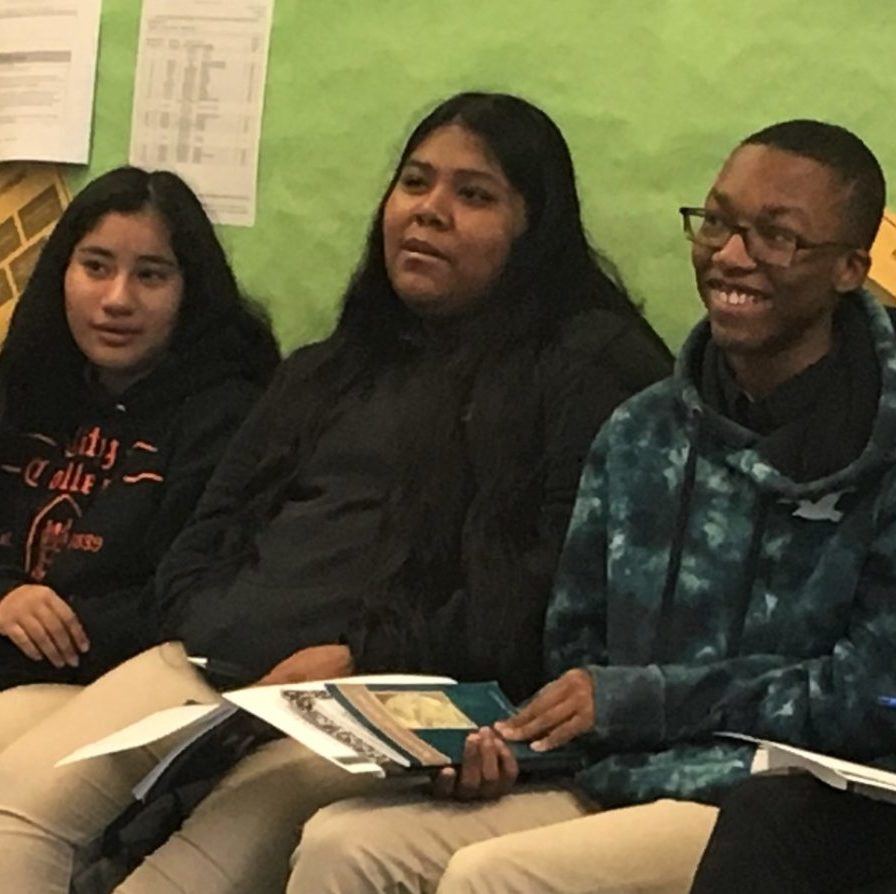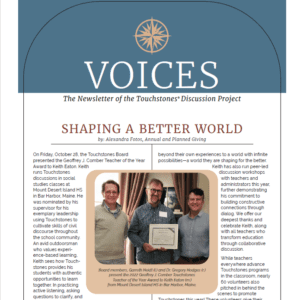How to Cultivate Collaborative Leadership in Your Class Discussions
by Brittany Usiak, K-12 and Adult Programs Manager
Today’s post is the fourth and final one in our series highlighting the Four Stages of Group Development in Touchstones with Stage 4: Collaborative Leadership. When we talk about Collaborative Leadership in Touchstones, we’re talking about a truly democratic learning environment; one where everyone – including the teacher – acts as both participant and leader to explore ideas together and shift toward more inclusive group dynamics. This type of classroom can often seem like a lofty goal when in the midst of the day-to-day responsibilities and demands of schools, but it’s possible for every class, even those with the youngest learners, to shift more responsibility for learning from the teacher to the students. It starts with invitations for reflection to strengthen self-awareness and creating opportunities for everyone to break out of the typical roles we play in classrooms. Touchstones builds these structures into the method, making it easier for teachers and students to move toward Collaborative Leadership.
Your role as a Touchstones discussion leader shifts from teaching content, as you do in a regular classroom setting to guiding your students through the activities in a way that allows them to take as much ownership of the process as possible over time. From the first Touchstones class, the students and teacher sit in a circle. This seating arrangement, as opposed to rows or a horseshoe configuration, encourages students to speak to one another and not through you, shifting their ideas about who is the expert in the room. During the first discussions, you are most responsible for the dynamics and content of the discussions. And while that will always be the discussion leader’s role, to some extent, an important part of the skill development in Touchstones comes from students’ solving problems and addressing group dynamics issues. As the year progresses and you engage in discussion evaluations and your own reflections, more responsibility for the discussion’s success is assumed by the students. They begin to see that everyone in their community of learners is responsible for establishing an inclusive space, not just you as the teacher. Here we’re underscoring strategies for how to build a classroom characterized by Collaborative Leadership before, during, and after each discussion.
Before the Discussion: Reflect on the previous lesson and decide on a goal for the next one
As part of your prep before each Touchstones class, start by reflecting on the problems or successes of past discussions. Each of our Teacher’s Guides includes tools to help you with this in the Appendices. As you reflect, think about the needs of your group and decide on a goal for the upcoming lesson that will inform the strategies you plan to use, the type of opening and follow up questions you will ask, what to look for in the small group work, or a skill or behavior that you need to model for your students. This preparation will also enable you to adjust quickly and respond appropriately to unanticipated issues or events because you will have a larger goal in mind. Each lesson is structured, but should be tailored to the needs of your particular class. If you use Touchstones with more than one class, this these goals will look different for each class section, as they will each be in a different stage of their group development.
During the discussion: Allow students the opportunity to recognize and self-correct behaviors that may be detrimental to the group.
As students build greater awareness of themselves and the group through discussion evaluations, they will need opportunities to put these new realizations into practice. Discussion skills, including anticipating the direction of a discussion, being aware of who is trying to speak, and keeping in mind the importance of both speaking and making room for others to speak are best achieved when students recognize the need for a solution in the moment.. For this reason, you might want to let some problems in group dynamics occur, allowing students the opportunity to find ways of addressing them.
For example, many students speaking at once is a common problem as classes begin Touchstones. Because it is usually a new experience for students to speak in class without raising their hands, you should expect situations in which three, four, or more students are speaking simultaneously. If many students are speaking at the same time, try allowing it to continue for a short time, perhaps ten seconds. Let students observe that the discussion has broken down. After this short period has passed, intervene if the group has not corrected the problem. You might say something like, “It’s impossible to understand anyone with so many people speaking at one time.” Then, ask the students to repeat what they were saying or even call on them successively without employing hand-raising. This approach lets students experience the problem and gives them a short-term solution. The goal then becomes students identifying the problem when it occurs and correcting it by themselves.
If you find that a particular problem reappears frequently, use a different approach. When the problem occurs and has not been corrected, stop the discussion, describe the problem, and ask the class to decide how to address it. If students disagree that a particular issue is a problem, give them the chance to explain why it is and what effect it has on them and the group. When you allow the students to suggest ways to avoid problems, some might want to introduce hand-raising or other forms of teacher-mediated taking of turns. However, always moving the discussion through the teacher hinders the development of students’ skills.
After the discussion: Use student observers and other evaluation tools regularly
As students build their skills in Collaborative Leadership, they should begin asking themselves, “What does the group need from me now?” during each discussion. Individual discussion evaluation forms, which we’ve written about previously, are one way to help students identify and reflect on their own strengths and areas for growth. After the 3rd or 4th Touchstones lesson, you can not only use the discussion evaluation tools, but also ask students to serve as observers. This gives them a valuable opportunity to practice observing and evaluating discussion dynamics in a group, much like you are doing as the teacher all the time!
When choosing observers, make sure to rotate through the class so every student gets to take on the role at different times. Student observers should participate fully in all other activities until it’s time for the whole group discussion, then they sit outside the discussion circle to observe using the provided form. Make sure to share this and the other Observer Guidelines (found in your Teacher’s Guide) with your student observer. It’s especially important that you coach students to speak about what they observe respectfully and objectively. Observers shouldn’t point out particular people, but rather should point out behaviors they specifically observe. Rather than saying, “Alex and Johnna talked too much!” They can say, “I noticed that some people talked a lot and other people didn’t talk at all.” After the discussion, make sure to allow enough time for the observers to share what they noticed.
In the comments, share your strategies for cultivating Collaborative Leadership with students or stories of Collaborative Leadership in your classroom. If you’re interested in adding more strategies to your toolbox, join us for an upcoming workshop.
This post is the fourth and final in a series on The Four Stages of group development.




 Join the
Join the